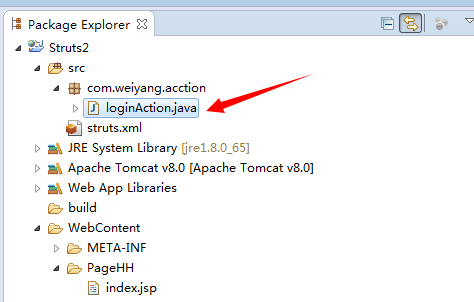最近在学struts2里面遇到很多错误,今天跟大家分享一下,我的开发工具是Eclipse;
1、到网上下载Struts2的包,这里不再累赘,百度有很多;
2、新建一个项目,记得后面加上web.xml文件;
3、先部署struts2开发环境。
(1)、在struts2.2以后,我们需要导入的包有以下几个:
commons-fileupload-1.2.1.jar
commons-io-1.3.2.jar
commons-logging-1.0.4.jar
commons-lang3-3.1.jar
freemarker-2.3.16.jar
javassist-3.7.ga.jar
ornl-3.0.jar
struts2-core-2.2.1.1.jar,
xwork-core-2.2.1.1jar
我通常都是把这些文件复制到WEB-INF/lib目录里。也可以在项目属性的Java Build Path中的libraries里面添加;
(2)、在lib文件夹下面的web.xml文件添加以下内容:
<filter> <filter-name>struts2</filter-name> <filter-class>org.apache.struts2.dispatcher.ng.filter.StrutsPrepareAndExecuteFilter</filter-class> </filter> <filter-mapping> <filter-name>struts2</filter-name> <url-pattern>/*</url-pattern> </filter-mapping>
现在web.xml文件是这样的
<?xml version="1.0" encoding="UTF-8"?> <web-app xmlns:xsi="http://www.w3.org/2001/XMLSchema-instance" xmlns="http://xmlns.jcp.org/xml/ns/javaee" xsi:schemaLocation="http://xmlns.jcp.org/xml/ns/javaee http://xmlns.jcp.org/xml/ns/javaee/web-app_3_1.xsd" id="WebApp_ID" version="3.1"> <display-name>Struts2Mianshi</display-name> <welcome-file-list> <welcome-file>index.html</welcome-file> <welcome-file>index.htm</welcome-file> <welcome-file>index.jsp</welcome-file> <welcome-file>default.html</welcome-file> <welcome-file>default.htm</welcome-file> <welcome-file>default.jsp</welcome-file> </welcome-file-list> <filter> <filter-name>struts2</filter-name> <filter-class>org.apache.struts2.dispatcher.ng.filter.StrutsPrepareAndExecuteFilter</filter-class> </filter> <filter-mapping> <filter-name>struts2</filter-name> <url-pattern>/*</url-pattern> </filter-mapping> </web-app>
(3)、在src目录下新建struts.xml文件,记住配置文件位置 在src目录下,命名struts.xml 小写。配置struts.xml文件
<?xml version="1.0" encoding="UTF-8"?> <!DOCTYPE struts PUBLIC "-//Apache Software Foundation//DTD Struts Configuration 2.0//EN" "http://struts.apache.org/dtds/struts-2.0.dtd"> <struts> <package name="main" extends="struts-default"> <!--这个里面写action配置--> </package> </struts>
4、在WebContent建一个文件夹存放JSP页面的(我建议还是建立一个Page文件夹 有利于文件的管理,还有后面的路径也好弄)
5、在Page文件里创建一个JSP文件命名index.jsp写登陆界面
<%@ page language="java" contentType="text/html; charset=UTF-8" pageEncoding="UTF-8"%> <% String RootPath=request.getContextPath(); %> <!DOCTYPE html PUBLIC "-//W3C//DTD HTML 4.01 Transitional//EN" "http://www.w3.org/TR/html4/loose.dtd"> <html> <head> <meta http-equiv="Content-Type" content="text/html; charset=UTF-8"> <title>登陆界面</title> </head> <body> <form action="<%=RootPath %>/login" method="post"> 登陆<br/> 账号:<input type="text" name="username" /><br /> 密码:<input type="password" name="userpwd" /><br /> <input type="submit" value="提交"/> </form> </body> </html>
<%=request.getContextPath()%>是为了解决相对路径的问题,可返回站点的根路径。
6、在src下创建一个包在创建一个loginAction.java 让这个类继承ActionSupport(action文件命名规则自己看)

看到JSp页面的账号username与密码userpws不。这边要获取就要命名跟他一样
private String UserName;并get、set 然后写execute()方法
package com.weiyang.acction; import com.opensymphony.xwork2.ActionSupport; @SuppressWarnings("serial") public class loginAction extends ActionSupport { private String username; public String getUsername() { return username; } public void setUsername(String username) { this.username = username; } public String getUserpwd() { return userpwd; } public void setUserpwd(String userpwd) { this.userpwd = userpwd; } private String userpwd; /** * execute方法会在该Action类被调用的时候自动执行, * 如果 账号="admin"并且密码="123456",就返回SUCCESS * 否则返回ERROR */ public String execute() { if(username.equalsIgnoreCase("admin") && userpwd.equalsIgnoreCase("123456")) { return SUCCESS; } else { return ERROR; } } }
7、action写好了就去配置struts.xml
<!--action标签的name是login,这个必须跟index.jsp中的action属性一致性。class是loginAction类的全称--> <action name="login" class="com.weiyang.acction.loginAction"> <!--这个标签的意思是当LogAction类的execute方法返回SUCCESS时,页面跳转到success.jsp--> <result name="success">WEB-INF/success.jsp</result> <result name="error">WEB-INF/error.jsp</result> </action>
login,这个必须跟index.jsp中的action属性一致性。class必须写loginAction类的全称
success 跟error是jsp文件 用来验证成功与失败 把他们新建在WEB-INF目录下
<result name="success">WEB-INF/success.jsp</result> 其他目录建立的写好路径
我的文件结构

个人理解的流程,web.xml文件中加入了strtus配置文件,所以index.jsp运行后指向action里面的login,在struts.xml文件找到login通过class找到action类,进行execute方法根据返回的success或者error又指向对应的jsp文件显示给用户。
开始做的时候 出现额404错误
<!--<constant name="struts.action.extension" value="action,do"></constant>--> 我在struts.xm文件中有这句运行index.jsp出现404
action="<%=RootPath %>/login" method="post"> 没有获取项目路径也是404,就是像这样action="login" method="post">
因为我建了一个文件夹PageHH存放jsp文件 所以路径就出现问题
最多的还是上面说的细节 命名,struts.xml文件里的配置不仔细出现的404
目前遇到的问题 在struts.xml文件包含了一个login.xml文件 让他代替struts.xml配置实现登陆模块,以后可以根据各自的功能建不同的配置文件。
<include file="login.xml"></include>
这句加上去 login.xml文件配置也没发现村 运行起来就出现404 还在找问题
初学者 大神勿喷!